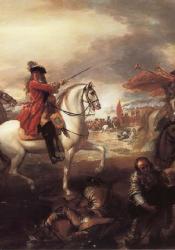The Glorious Revolution
The Glorious Revolution happened when King James II was dethroned and his daughter Mary II and her husband William III, ascended. When King James II came into power, his overt Roman Catholicism alienated the majority of the population. The revolution was motivated both politically and religiously and was thus very complex. In the end it gave parliament more control over the monarchy which eventually led to the formation of a more political democracy.
To get into more detail, King James II was Catholic and issued a Declaration of Indulgence suspending penal laws against Catholics (the laws that punish its offenders) and granted acceptance of some Protestant nonconformists. He then formally dissolved his Parliament and attempted to create a new Parliament that would support him unconditionally in his catholic ways of governing and beliefs. Feeling that Catholic dynasty was imminent, the Wigs, who were the main group that opposed catholic succession, were especially outraged.
The fear of King James succeeding in this only grew when in 1688, King James II had a son, James Francis Edward Stuart, that pushed his older Protestant daughter Mary out of the spot as his heir. It became especially worrisome to nonconformists, which were the majority of the country, when King James II announced that his new son and heir would be raised catholic.
With these new announcements and the growing terror of the public, seven of James’s peers wrote to the Dutch leader William of Orange, saying that they would pledge their allegiance to him if he agreed to invade England. William was already planning to take military action against England, so these letters only encouraged him more.
King James had prepared for military attacks though and left London in order to bring his forces to meet the invading army that were backed by William of Orange. However, several of James’s men, including his family members, deserted him, and instead sided with William’s cause.
James then attempted to flee after returning to London in fear of his safety but was captured. He again tried to leave and successfully made it to France where his Catholic cousin Louis XIV held the throne. King James died there in Exile in 1701.
It was then that the new Convention Parliament met and after significant pressure from William, agreed to a joint monarchy with William as king and James’s daughter, Mary, as Queen. The joint monarchy agreed to more restrictions from parliament, and signed what would become a Bill of Rights, as well as the right for regular Parliaments, free elections, and freedom of speech in Parliament. They also forbade the monarchy form being Catholic. Historians believe that this Bill of Rights was the first step towards a constitutional monarchy.
This is the point in history that has ultimately led to Parliament’s increasing power in Britain while the monarchy’s influenced has waned.

